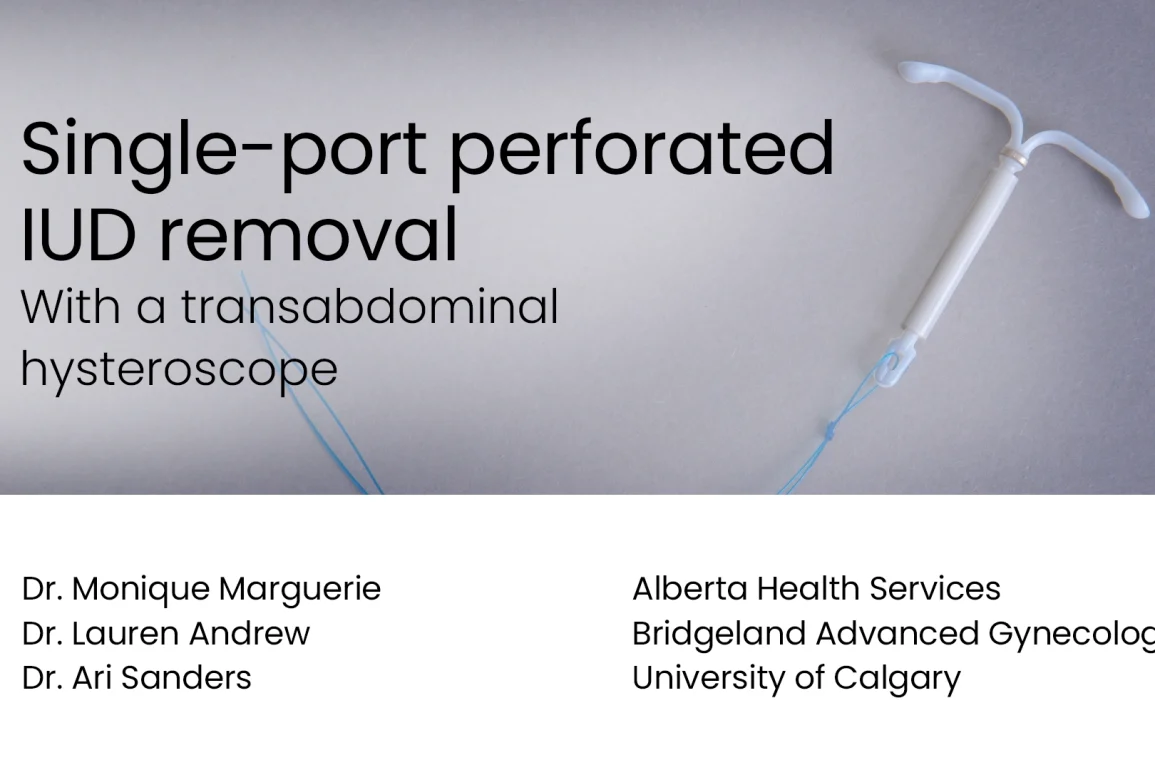Table of Contents
- Procedure Summary
- Authors
- Youtube Video
- What is Single-port Perforated IUD Removal with a Transabdominal Hysteroscope?
- What are the Risks of Single-port Perforated IUD Removal with a Transabdominal Hysteroscope?
- Video Transcript
Video Description
Watch the single-port laparoscopic removal of a perforated IUD using a transabdominal hysteroscope, highlighting access, visualization, and safe retrieval steps.
Presented By
Affiliations
Alberta Health Services, Bridgeland Advanced Gynecology, University of Calgary
Watch on YouTube
Click here to watch this video on YouTube.
What is Single-port Perforated IUD Removal with a Transabdominal Hysteroscope?
Single-port perforated IUD removal with a transabdominal hysteroscope is a minimally invasive technique for extracting an intrauterine device that has perforated the uterus and migrated into the abdominal cavity. Here’s what it involves:
- Single-port Access: A single abdominal trocar is placed to allow entry of a three-channel hysteroscope, avoiding multiple laparoscopic ports.
- Imaging Review: Preoperative X-ray or ultrasound is used to localize the IUD and plan port placement.
- Abdominal Survey: After entry, the pelvis is inspected to identify the IUD and assess for adhesions or injury to surrounding organs.
- Grasping and Release: Hysteroscopic graspers are used to carefully free the IUD from any omental or peritoneal adhesions.
- Extraction: The IUD is removed through the single port, eliminating the need for a larger incision or multi-port laparoscopy.
What are the Risks of Single-port Perforated IUD Removal with a Transabdominal Hysteroscope?
This procedure is highly effective but carries risks similar to other minimally invasive abdominal surgeries.
- Bleeding: Injury to small vessels during port placement or adhesion dissection can cause intra-abdominal bleeding.
- Organ Injury: The bowel, bladder, or omentum may be damaged during entry or when releasing dense adhesions around the IUD.
- Infection: Contamination from the perforated IUD or intra-abdominal manipulation can lead to postoperative infection or abscess formation.
- Incomplete Removal: Dense adhesions may obscure the IUD, increasing the chance of retained fragments requiring repeat surgery.
- Conversion to Multi-port or Open Surgery: If visualization is inadequate or bleeding occurs, additional ports or a larger incision may be needed.
- Anesthetic and Entry Complications: Single-port access carries the usual risks of laparoscopic surgery, including port-site hernia, gas embolism, or injury during insufflation.
Thorough preoperative imaging, careful single-port entry, and meticulous hysteroscopic dissection help reduce these complications while enabling safe, minimally invasive IUD retrieval.
Video Transcript:
The University of Calgary presents single-port perforated IUD removal with a transabdominal hysteroscope. In this video, we will review risk factors and consequences of uterine perforation with IUD insertion, identify situations in which a single-port transabdominal hysteroscope should be considered, review operative preparation and setup required, and demonstrate the proposed technique through case review.
A study published earlier this year found that 28% of Canadian women using contraception have an IUD. The incidence of uterine perforation with insertion of IUDs has been found to be between 0.2 and 3.6 perforations per 1,000 insertions. Certain populations may be at an increased risk for uterine perforation, including those who are lactating, recently postpartum, have uterine anomalies or have adenomyosis. If the practitioner is inexperienced in IUD insertion, this also increases the risk of perforation.
The majority of perforated IUDs are asymptomatic, however they may cause pain or abnormal bleeding. Rare, but serious complications include bowel or bladder perforation, fistula formation, and abscess formation. The use of a hysteroscope transabdominally makes it possible to extract a perforated IUD with only a single port. This is the most minimally invasive approach we can provide patients, and thus it should be considered for all patients when appropriate.
Patients who may not be appropriate for the use of this method include those with a history warranting a left upper quadrant entry as the hysteroscope will likely not reach the pelvis, as well as those with suspected bowel or bladder perforation, or an abscess. Studies have shown that copper IUDs are more likely to have surrounding adhesions than progestin IUDs, but often these can still be managed with a single-port hysteroscope approach.
Prior to taking the patient to the OR, a review of the patient’s X-ray can demonstrate where you’re most likely to find the IUD. In the case shown here the IUD is in the upper mid pelvis to the left of midline.
Here, we are about to perform a single-part transabdominal extraction of a perforated IUD using a standard 3-channel hysteroscope. In this case, we are using an 8 mm disposable trochar, however most hysteroscopes will also fit down a disposable 5 mm plastic trochar if this is what’s available to you. We are using a 30 degree hysteroscope with a standard 3-channel hysteroscopic sheath.
Upon entry into the abdomen, a full survey of anatomy should be performed. A uterine manipulator can be used to help expose the anatomy and identify the location of the perforated IUD. The uterine manipulator can be as simple as a Pratt dilator Steri-Strip to a single-tooth tenaculum as was used in this case.
The first case we present is a straightforward IUD removal with minimal surrounding adhesions. The patient presented with some cramping one week following IUD insertion. Ultrasound was unable to locate the IUD, and an X-ray confirmed intraabdominal location. The patient’s X-ray located the IUD in her right hemipelvis. The IUD and IUD strings were seen upon entry into the abdomen, thus the uterine manipulator was not needed for IUD identification, only for the survey of anatomy, which had already been performed.
In this case, a toothed hysteroscopic grasper was used, which allows for greater purchase when grasping the IUD and the IUD strings. The IUD strings can be easier to grasp than the IUD, but sometimes grasping the IUD is also required if the IUD is located within the omentum, such as this case. Once the IUD is free from the surrounding attachments, grasping the IUD string will make it easier to remove the IUD from the pelvis.
As with uterine hysteroscopy, the hysteroscope and graspers move together, but also independently of each other. This is a translatable skill from hysteroscopy, but can take some getting used to in a much larger space. Our second case demonstrates that even when the IUD is adherent within the omentum, it can be removed with our hysteroscope method.
This patient presented one year following IUD insertion with a positive pregnancy test. She subsequently miscarried, and her IUD was found to be intraabdominal on imaging.
The patient’s X-ray and survey of anatomy were shown earlier. The IUD was found in the left mid pelvis. The IUD stem has much more dense surrounding omental adhesions, likely because the IUD has been intraabdominal for greater than one year compared to our first case, who presented after only one week. The adhesions make it difficult to gain traction on the IUD.
As you can see, a short and blunt non-toothed grasper was used in this case, because this is what was available. The use of a larger toothed grasper may have allowed for greater purchase on the IUD. In order to release some of the adhesions, the IUD was pulled up against the port to act like a second instrument. This released the surrounding omental adhesions and allowed for release of the IUD. Once freed from the adhesions, the tail can be grasped and the IUD extracted.
This case was a good example that, while retrieval of an IUD with surrounding adhesions can add a layer of complexity to the IUD retrieval, it is definitely possible and should still be considered.
Single-port surgery is the most minimally-invasive method for IUD extraction, and this method should be considered for most patients.
Imaging should be reviewed prior to the OR. Basic instruments are listed here. A toothed hysteroscopic grasper is ideal if available, but not essential. Even IUDs with moderate surrounding adhesions are reasonable to extract in this method. Thank you.




